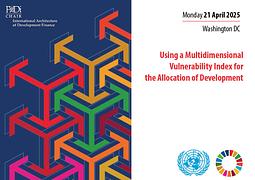
📅 21 April 2025, 9:30AM – 11:30AM Eastern Time
📍Open Society Foundations, 1730 Pennsylvania Avenue, NW 7th Floor
Washington, DC 20006, United States
Organised by UN-OHRLLS and UN-DESA
in collaboration with FERDI, AfriCatalyst, the Open Society Foundations (OSF), the Paris Pact for People and Planet (4P), the Executive Director for Africa Group I, the Executive Director for Africa Group II, and the Executive Director for France at the World Bank Group.
The objective of the meeting is to explore the rationale and feasibility of, as well as possible obstacles to, the use of an index of multidimensional and structural vulnerability for allocation of and access to concessional resources. The discussion will also consider how such an index can complement other existing variables used to measure country development financing needs and its’ allocation.
Expected Outcomes
Welcome remarks
Mr. Desire Assogbavi, Advocacy Advisor Open Society Foundations (OSF)
Opening remarks
Mr. Abdoul Salam Bello, Chief OHRLLS
Ms. Chrysoula Zacharopoulou, Acting Chair of the Paris Pact for People and the Planet 4P and, French former Minister of State for Development, Francophonie, and International Partnerships (by video)
Prof. Patrick Guillaumont, President FERDI
Mr. Daouda Sembene, Founder and CEO AfriCatalyst
Keynote address
H.E. Mr. Olavo Correia, Vice Prime Minister and Minister of Finance and Business Development, Cabo Verde
Dr. Louise Fox, UN Consultant and former Member of the UN-High-Level Panel on the MVI
How MDBs currently consider vulnerability in assessing the financing needs of developing countries
Prof. Patrick Guillaumont, President FERDI
Why and how they can use a vulnerability index in their allocation rules, what are the obstacles to do so, how those could be overcome.
Mr. Ed Mountfield, Vice President for Operations Policy and Country Services (OPCS, World Bank
Comments by Executive Directors at the World Bank Group
Mr. Zarau Kibwe, Executive Director for Group Africa I
Mr. Harold Tavares, Executive Director for Group Africa II
Mr. Arnaud Buissé, Executive Director for France
Mr. Zarau Kibwe, Executive Director for Group Africa I at the WBG